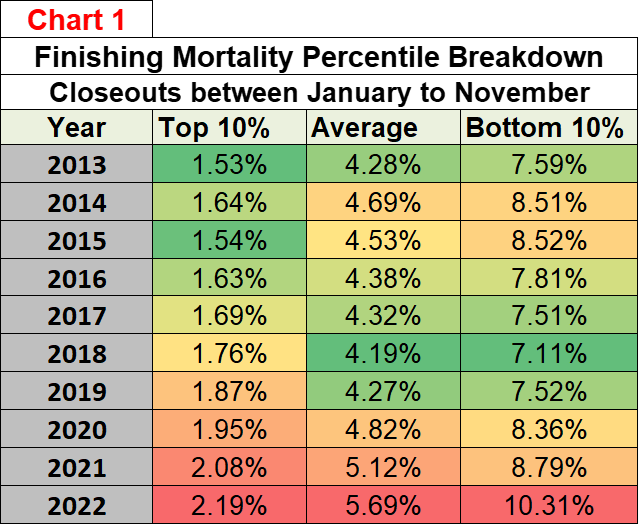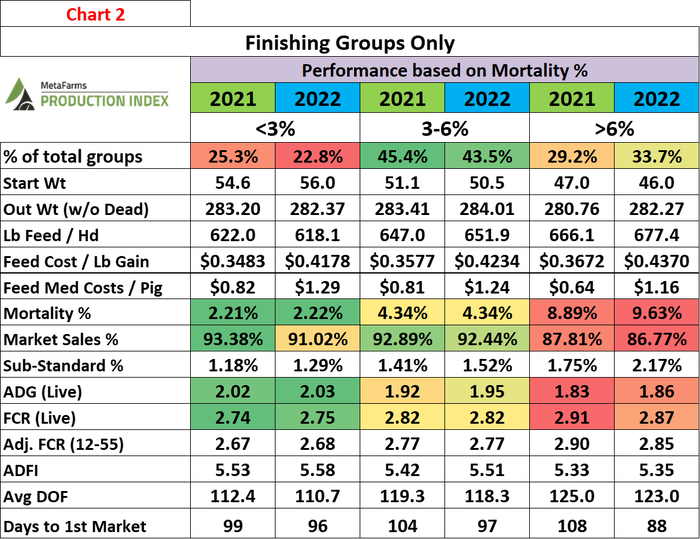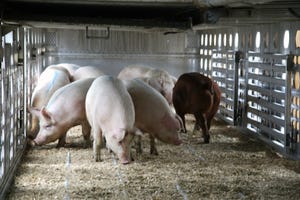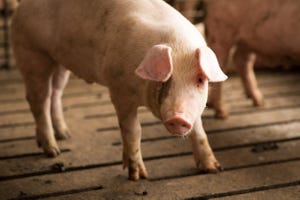Finishing mortality rates continue to rise
April mortality rate of 6.12% was the high month's average for 2022. Are we seeing the grow/finish impact of the PRRS Lineage 1C 1-4-4 strain?
January 4, 2023

At the 2022 National Pork Industry Conference, keynote speaker and best-selling author David Horsager spoke about how leaders and organizations can drive the best business results through trust. Horsager did a great job of breaking trust into eight different pillars, from clarity to compassion to communication and so on.
He was also fantastic in challenging the audience on the "how" aspect of building trust through those pillars. "How are you going to change?" "How will you make sure that aspect of your life will work?" "How, how, how?"
For the fifth straight year, finishing closeout mortality averages have risen and the bottom 10% average is at an all-time high, so as an industry, "how" are we going to change this trend?
All closeouts are based on a standardized set of business logic and calculation algorithms which allows our analysts and users to make apples-to-apples comparisons of performance across and within companies using the MetaFarms Ag Platform.
Finishing closed group analysis was performed utilizing the MetaFarms Ag Platform, with specific focus on the United States customers only. In the first 11 months of 2022, the U.S. MetaFarms customers had slightly more than 10,000 closeouts (10,009) with total pigs started over 18,000,000.
Characteristics of a finishing group would be a starting average weight around 45 pounds with an ending average weight out of 285 pounds. Pigs are normally on feed for around 120 days, have an average daily gain of a 1.90, and have a feed efficiency rate of 2.87. As previously stated, finishing groups are generally on feed for 120 days, or four months. Groups starting in April would not close out until July or August.
Chart 1 analyzes the last 10 years of finishing closeouts, broken down into three different percentiles ranges, from the best (Top 10%) to the worst (bottom 10%), along with the yearly average. 2021 had the distinction of having each of its percentiles, along with the average of being the highest across all previous years, but those have now been superseded by closeouts in 2022. The biggest outlier is the Bottom 10% where in 2022, the 10.31% was 1.52% higher than 2021 (17.3% change).
Let's put some actual numbers to how bad the bad closeouts are getting. In a 1,000 head barn, in 2018 the bottom 10% was 7.11% so the total death pig death totals would have been 71 pigs. In 2022, the total number of dead's would have been 103 — 32 more pigs or 1 extra dead every 3.75 days (assuming 120 days on feed).

Chart 2 analyzes finishing closeout data that separates 2022 closeout finishing groups from 2021 across three different mortality percentage ranges. Closeouts that fell within the mortality ranges will have their performance, and financial metrics, as part of that range.
Looking at this type of performance comparison, based on mortality rates, is beneficial in several aspects. With higher feed costs in 2022, analyzing this type of year-over-year comparison shows the financial impact on mortality with much higher 2022 feed cost per pound of gain. Difference from 2022 to 2021, per mortality range, saw a cost difference of $0.0657 to $0.0698, with percentage change increase of 18.4% to 20.0%. With higher feed costs, the focus on keeping pigs alive proves even more important to the bottom line for a pork producer.

Chart 3 looks at the last five years of finishing closeout mortality rates, by month, where every month within 2022, was higher than the previous four years equivalent. The April mortality rate of 6.12% was the high month's average for 2022; 0.66% higher than 2021 (12% change), and 1.86% (43.7% change) from the same period in 2018. The April 2022 closeouts were higher where these groups would generally have started in December 2021, which means that the nursery groups would have started in October 2021. Porcine reproductive and respiratory syndrome historically sees new incidents occurring in the late fall/early winter months. Perhaps we are seeing the grow/finish impact of the Lineage C 1-4-4 virus.

How is the industry going to fix this issue? As cheesy or mundane as it may sound, everyone needs to participate and be active to mitigate the issues at hand. Below are some brief notes on what and how different roles can help impact mortalities.
Caretakers:
You are on the front lines of defense.
When new pigs arrive, ensure they are coming into a clean home that has the proper food, water and ventilation.
Treat the right pig, at the right time, and with the right product.
Communicate when something does not look right.
See every pig, every day. This may seem simple for most of us but how often are the "little things" being missed?
Transportation/Truckers:
Ensure your equipment has been properly cleaned and disinfected. Disease is hard enough to keep out of a barn. Don't drag it from one location to another by being sloppy.
Management/Supervisors:
When receiving new pigs, know the health history. Is there a history of strep? Looseness? What can be done to help offset these issues?
Educate the caretakers. Explain what the importance of proper feed, water and air is.
Ownership/Executives:
Don't accept mediocre closeout performance. Find out the why and what you can do to help.
Promote communication and collaboration within your own company as well as with other producers.
The pork industry has been trending the wrong way with mortalities for years, and while there has been a lot of research done with new medications and vaccines developed, this issue has not improved but rather worsened. Unfortunately, there is not a magic solution or any easy button, so producers need to work in collaboration with other producers to minimize those human mistakes. Albert Einstein's Parable of Quantum says, "Insanity is doing the same thing over and over and expecting a different result."
MetaFarms Analytic Insights were used to provide the context and trends for this article. If you would like to see an analysis of how mortality is affecting your finishing performance, or if you have suggestions on production areas to write articles about, please e-mail or call us. We enjoy being a part of the National Hog Farmer montly preview team. Previous production columns can be found on the National Hog Farmer site.
If you have questions or comments about these columns, or if you have a specific performance measurement that you would like us to write about, please contact: Bradley Eckberg.
You May Also Like



